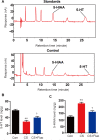Predator stress-induced depression is associated with inhibition of hippocampal neurogenesis in adult male mice
- PMID: 30531013
- PMCID: PMC6301170
- DOI: 10.4103/1673-5374.244792
Predator stress-induced depression is associated with inhibition of hippocampal neurogenesis in adult male mice
Abstract
Stress has been suggested to disturb the 5-hydroxytryptamine system and decrease neurogenesis, which contribute to the development of depression. Few studies have investigated the effect of predator stress, a type of psychological stress, on depression and hippocampal neurogenesis in adult mice; we therefore investigated this in the present study. A total of 35 adult male Kunming mice were allocated to a cat stress group, cat odor stress group, cat stress + fluoxetine group, cat odor stress + fluoxetine group, or a control group (no stress/treatment). After 12 days of cat stress or cat odor stress, behavioral correlates of depression were measured using the open field test, elevated plus maze test, and dark-avoidance test. The concentrations of hippocampal 5-hydroxytryptamine and 5-hydroxyindoleacetic acid were measured using high-performance liquid chromatography-electrochemical detection. Neurogenesis was also analyzed using a bromodeoxyuridine and doublecortin double-immunostaining method. Cat stress and cat odor stress induced depression-like behaviors; this effect was stronger in the cat stress model. Furthermore, compared with the control group, cat stress mice exhibited lower 5-hydroxytryptamine concentrations, higher 5-hydroxyindoleacetic acid concentrations, and significantly fewer bromodeoxyuridine+/doublecortin+-labeled cells in the dentate gyrus, which was indicative of less neurogenesis. The changes observed in the cat stress group were not seen in the cat stress + fluoxetine group, which suggests that the effects of predator stress on depression and neurogenesis were reversed by fluoxetine. Taken together, our results indicate that depression-like behaviors induced by predator stress are associated with the inhibition of hippocampal neurogenesis.
Keywords: 5-hydroxyindoleacetic acid; 5-hydroxytryptamine; behavioral evaluation; cat odor stress; cat stress; dark-avoidance test; depressive disorder; elevated plus maze test; hippocampal neurogenesis; nerve regeneration; neural regeneration; open field test.
Conflict of interest statement
None
Figures





Similar articles
-
Dynamic changes of behaviors, dentate gyrus neurogenesis and hippocampal miR-124 expression in rats with depression induced by chronic unpredictable mild stress.Neural Regen Res. 2020 Jun;15(6):1150-1159. doi: 10.4103/1673-5374.270414. Neural Regen Res. 2020. PMID: 31823896 Free PMC article.
-
A P2X7 receptor antagonist reverses behavioural alterations, microglial activation and neuroendocrine dysregulation in an unpredictable chronic mild stress (UCMS) model of depression in mice.Psychoneuroendocrinology. 2018 Nov;97:120-130. doi: 10.1016/j.psyneuen.2018.07.016. Epub 2018 Jul 10. Psychoneuroendocrinology. 2018. PMID: 30015007
-
S 47445 Produces Antidepressant- and Anxiolytic-Like Effects through Neurogenesis Dependent and Independent Mechanisms.Front Pharmacol. 2017 Jul 19;8:462. doi: 10.3389/fphar.2017.00462. eCollection 2017. Front Pharmacol. 2017. PMID: 28769796 Free PMC article.
-
Antidepressant-like effects of Xiaochaihutang in a neuroendocrine mouse model of anxiety/depression.J Ethnopharmacol. 2016 Dec 24;194:674-683. doi: 10.1016/j.jep.2016.10.028. Epub 2016 Oct 13. J Ethnopharmacol. 2016. PMID: 27746334
-
Requirement of AQP4 for antidepressive efficiency of fluoxetine: implication in adult hippocampal neurogenesis.Neuropsychopharmacology. 2009 Apr;34(5):1263-76. doi: 10.1038/npp.2008.185. Epub 2008 Oct 15. Neuropsychopharmacology. 2009. PMID: 18923397
Cited by
-
Fasting produces antidepressant-like effects via activating mammalian target of rapamycin complex 1 signaling pathway in ovariectomized mice.Neural Regen Res. 2023 Sep;18(9):2075-2081. doi: 10.4103/1673-5374.367928. Neural Regen Res. 2023. PMID: 36926734 Free PMC article.
-
Understanding stress: Insights from rodent models.Curr Res Neurobiol. 2021 May 23;2:100013. doi: 10.1016/j.crneur.2021.100013. eCollection 2021. Curr Res Neurobiol. 2021. PMID: 36246514 Free PMC article. Review.
-
Immune receptor toll-like receptor 4 contributes to stress-induced affective responses in a sex-specific manner.Brain Behav Immun Health. 2021 Mar 31;14:100248. doi: 10.1016/j.bbih.2021.100248. eCollection 2021 Jul. Brain Behav Immun Health. 2021. PMID: 34589759 Free PMC article.
-
The neuroimmunology of social-stress-induced sensitization.Nat Immunol. 2022 Nov;23(11):1527-1535. doi: 10.1038/s41590-022-01321-z. Epub 2022 Nov 11. Nat Immunol. 2022. PMID: 36369271 Free PMC article. Review.
-
Animal models of major depression: drawbacks and challenges.J Neural Transm (Vienna). 2019 Nov;126(11):1383-1408. doi: 10.1007/s00702-019-02084-y. Epub 2019 Oct 4. J Neural Transm (Vienna). 2019. PMID: 31584111 Free PMC article. Review.
References
-
- Airan RD, Meltzer LA, Roy M, Gong Y, Chen H, Deisseroth K. High-speed imaging reveals neurophysiological links to behavior in an animal model of depression. Science. 2007;317:819–823. - PubMed
-
- Apfelbach R, Blanchard CD, Blanchard RJ, Hayes RA, McGregor IS. The effects of predator odors in mammalian prey species: a review of field and laboratory studies. Neurosci Biobehav Rev. 2005;29:1123–1144. - PubMed
-
- Bourin M, Hascoët M. The mouse light/dark box test. Eur J Pharmacol. 2003;463:55–65. - PubMed
-
- Brezun JM, Daszuta A. Serotonin may stimulate granule cell proliferation in the adult hippocampus, as observed in rats grafted with foetal raphe neurons. Eur J Neurosci. 2000;12:391–396. - PubMed
LinkOut - more resources
Full Text Sources
Miscellaneous

